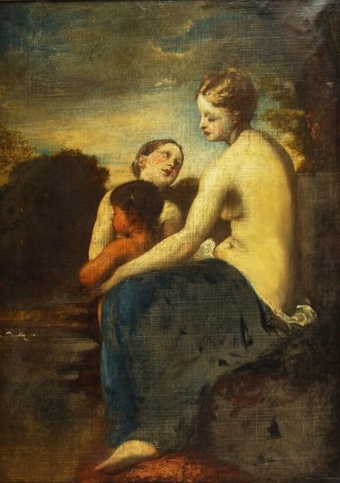portrait of a member of the luttrell family
- View other items in:
- antiques interior design modern and vintage
- other interior design
artware ltd
Enquire about this antique
Artware Ltd has 565 antiques for sale.
click here to see them all
The Luttrell Family are an ancient family from Devon. The family have lived at Dunster Castle since the end of the 14th century when they purchased Dunster Castle from the De Mohuns family. The castle was expanded several times by the Luttrell family during the 17th and 18th centuries; they built a large manor house within the Lower Ward of the castle in 1617, and this was extensively modernised, first during the 1680s and then during the 1760s. The medieval castle walls were mostly destroyed following the siege of Dunster Castle at the end of the English Civil War, when Parliament ordered the defences to be slighted to prevent their further use. In the 1860s and 1870s, the architect Anthony Salvin was employed to remodel the castle to fit Victorian tastes; this work extensively changed the appearance of Dunster to make it appear more Gothic and Picturesque.
Henry''s son, John, inherited the castle in 1780, but when his son, also called John, inherited in 1816 he chose to live in London instead, opening up Dunster Castle to the public. By 1845 the castle appeared to visitors to be past its prime: with only two of John''s sisters living there and no horses or hunting dogs left in the castle grounds, the remaining servants had little to do. John''s brother Henry inherited in 1857, but he too lived in London rather than at Dunster. George Luttrell inherited the castle in 1867 and began an extensive modernisation, backed by the considerable income from the Dunster estates ? in a period of agricultural boom in England, the estates were producing ?22,000 in revenue a year (?1.49 million at 2010 prices). It was fashionable during the mid-Victorian period to remodel existing castles to produce what was felt to be a more consistent Gothic or sometimes Picturesque appearance and George, a keen historian, decided to follow this trend at Dunster; in the process, he also hoped to accommodate the larger household and facilities required for a 19th-century landowner: by 1881, the castle required 15 "living-in" servants alone. He employed Anthony Salvin, a noted architect then most famous for his work at Alnwick Castle, to carry out the work between 1868 and 1872 at a total cost of ?25,350 (equivalent to ?1.76 million as of 2010).
Antiques.co.uk Ref: KMKGPYKB
- Materials:
- Oil on Canvas
- Width (cm):
- 30 x 25in. (76 x 64cm.)
Artware Ltd
Artware Fine Art specialises in fine antique, decorative and historical portraits and topographical pictures . We cover a period from the 17th and 18th centuries through to the 19th & 20th Centuries. We have over 150 portraits in stock, which can be viewed on our web site, each historical portrait has well researched biographical information both on the sitter and the artist.
Contact details
18 La gare
51 Surrey row
London
Greater London
SE1 0BZ
UNITED KINGDOM
T: 0207 921 97904
E: greg@artwarefineart.com
W: www.artwarefineart.com














